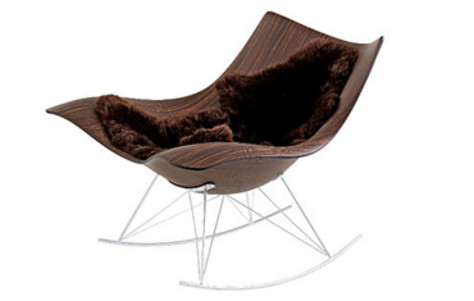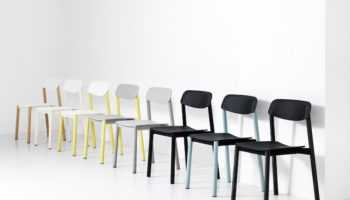Stingray
The Stingray Rocker by Thomas Pedersen for Fredericia Furniture is one of those seminal pieces that illustrates the fusion of tradition and innovation. The story of this chair is really the story of the two Thomases-designer Pedersen and manufacturer Graversen-whose collaboration resulted in the debut of the original Stingray (model in black suction-vacuumed plastic) in 2006.
Stingray rocker. Designed by Thomas Pedersen. Manufactured by Fredericia Furniture.
Thomas #1, head man at Fredericia, inherited all the baggage associated with the legacy of two pioneers in Scandinavian design, Father Andreas and famed designer Børge Mogensen. Graversen the younger took over the reins in 1995 and wisely continued his predecessors’ philosophy of integrating the best of Danish design technique (a short list might include straight lines, simple design, scant ornamentation, high functionality, and clear finishes that emphasize the grain) with advances in furniture engineering as well as new materials. Graversen is also an excellent businessman: he made the wise choice to protect and secure the legacy of the Graversen-Morgensen duo by purchasing rights to the most important Børge Mogensen furniture together under one roof, including classics such as the slat sofa and the braided chair J39.
The story of Thomas #2 begins in 2002 in the parking lot outside the Aarhus School of Architecture, where Pedersen and a colleague had repaired to complete their graduation project because “the school had an excellent wood workshop but no facilities for working in metal or glass fibre.” In spite of the miniature tornado of glass and steel dust, which settled on instructors’ cars and provoked not a little eyebrow wrinkling, Pedersen’s risk paid off, for it set the stage for his creation of Stingray, which got more than a few pundits talking about the young designer.
Pedersen says the design was inspired by the namesake, as well as by the kind of linguistic coincidence that sometimes creates the ideal connection between the function of a piece and what we choose to call it: ” The Danish word for stingray is "rokke" which sounds like the first part of the word "rock" in "rocking chair" and the shell does resemble a giant stingray moving across the seabed. But it was the functionality that came first, not the design.” The base of the chair is made of criss-crossed lengths of diagonally oriented steel, which gives an impression of dynamism and tensile mobility-the chair looks like it could harness the potential energy of the subtly compressed shafts and launch itself starward. The aquatic connotations exist as well. Not only does it resemble the cartilaginous fish it’s named for, but also any one of several mollusks-proximal inhabitants of sandy shoals and enshadowed coral beds. As you fold yourself into the Stingray’s space-agey yet womb-like confines, you might feel as if you’ve entered the sacrosanct space of an oyster’s shell, where you can ward off all extra-sensory input and allow the ocean’s oscillations to rock you into bliss.
In 2008 Fredericia introduced the Stingray in wood veneer-harking back to more traditional Danish designs-which garnered it the “Interior Innovation Award Cologne 2008.” It’s currently available in both veneered wood (oak, walnut, or the African wood makassar) and vacuum-suctioned plastic in black or white.





Leave a Reply